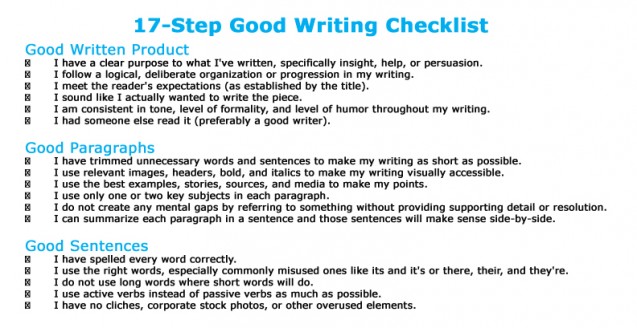
One important lesson from “The Checklist Manifesto” is the idea of creating checklists to guard against failures in complex situations. Investment manager Mohnish Pabrai studied his own investment failures as well as those of notable investors like Warren Buffett and ended up with a 70-point checklist, meant to keep himself from repeating the same mistakes as he evaluated investment opportunities.
I’m morally opposed to a 70-point anything, but a “complex situation” I encounter every day is writing. I think 80 percent of bad writing can be avoided by eliminating a handful of the biggest problems. The biggest of these problems is our inability to see our own shortcomings as writers. I only know a few people who openly claim to be poor writers, but they often can’t articulate what makes them poor.
Ask yourself, “Can I read an article or an e-mail and describe exactly what makes it good or bad writing?” If you can’t critique someone else’s writing, you’re probably missing many of your own mistakes (as well as strengths you’d want to repeat). Since most big writing problems can be easily averted, I created a checklist of the biggest things you should check in your own writing before you hit “Publish.”
The checklist is specific to web writing and blogging, though the majority of points are applicable to any writing situation.
Click the image to expand.

Here, I’ve included the same list with some added detail.
Good Written Product
- “I have a clear purpose to what I’ve written, specifically insight, help, or persuasion.” There must be a point to what you’re writing, and hopefully there’s a point to why YOU are the one writing it instead of someone else. You also need to have an objective so you can avoid rambling.
- “I follow a logical, deliberate organization or progression in my writing.” I find it easiest to create a brief outline of the major points I want to cover before writing anything. Your writing should feel either like a story or a text book (preferably a mixture of both).
- “I meet the reader’s expectations (as established by the title).” Your title should set up an interesting expectation. Your content should fulfill that expectation. Consider every word of your title and whether you can actually deliver on the implied promise. For example, a title like “The 12 Best Things You Can Do With 5 Spare Minutes” sets up multiple expectations. You’d better have 12 things, each of those things should only take 5 minutes, and most importantly, the reader must not be able to easily think of anything better than the 12 you’ve come up with (because of the lofty inclusion of the word ‘best’).
- “I sound like I actually wanted to write the piece.” Your excitement should be evident in your setup and word choice. If you’re not excited to write, should a reader be remotely excited to read?
- “I am consistent in tone, level of formality, and level of humor throughout my writing.” Inconsistency takes on many forms. Don’t inject one joke into a whole paper full of formal seriousness. Don’t use street talk or informalities unless there’s a good reason to and you’ll be using them from opening paragraph to closing paragraph.
- “I had someone else read it (preferably a good writer).” The biggest help to any writing is a 2nd set of eyes. Look for someone who can provide high-level feedback on the concepts, flow, and organization as well as minutiae like spelling and grammar.
Good Paragraphs
- “I have trimmed unnecessary words and sentences to make my writing as short as possible.” An example of an unnecessary sentence is something like, “Here’s what I think about it.” Every sentence you write should add value in some way.
- “I use relevant images, headers, bold, and italics to make my writing visually accessible.” Your blog post should not look like the five-paragraph essay you wrote for Mrs. Howard’s English class in high school. People don’t read web pages. They skim. And you need to take that into account in how you set up the page and your most important points.
- “I use the best examples, stories, sources, and media to make my points.” Mediocre stories and examples aren’t worth writing. They don’t stick and they rarely persuade. Stories and examples from our personal lives often fall into the “mediocre” category and we have to be willing to leave them out in order to accomplish our writing objectives.
- “I use only one or two key subjects in each paragraph.” One of the easiest ways to lose a reader is to give each sentence a different subject within the same paragraph . The reader can become confused. The flow of reading is often hindered. It’s best if you stick to no more than two subjects for consistency and clarity. I find it helps me and my readers. (See what I did there?)
- “I do not create any mental gaps by referring to something without providing supporting detail or resolution.“
- “I can summarize each paragraph in a sentence and those sentences will make sense side-by-side.“
Good Sentences
- “I have spelled every word correctly.” I’m always amazed when I get Word documents sent to me with spelling errors. I encourage the use of Spell Check.
- “I use the right words, especially commonly misused ones like its and it’s or there, their, and they’re.“
- “I do not use long words where short words will do.” Hat tip to George Orwell’s Six Rules.
- “I use active verbs instead of passive verbs as much as possible.” Another George Orwell favorite.
- “I have no clichés, corporate stock photos, or other overused elements.” If you can’t keep from using a clichéd phrase, try swapping out a word or two to give it a familiar meaning with a unique twist. I like to use TinEye to determine whether the picture I’m about to use has already been used in many other places. I’ve seen great writing that loses a lot of credibility because of a boring corporate stock photo.
The ability to write coherently is grossly undervalued. That ability is the first thing I look for in potential hires and the reason I instantly toss many resumes. Why? Because communication is a basic job function and teaching college graduates how to write coherently is not what we meant by on-the-job training.
If you’re trying to improve as a writer (or struggling with the quality of other writers and bloggers), hopefully you can use the checklist to eliminate some of the trouble spots. You may find it slow-going at first, checking your work against all 17 points, but ideally each point will become instinctual with enough repetition.
Any tips of your own that you use (or teach) to eliminate writing problems?




